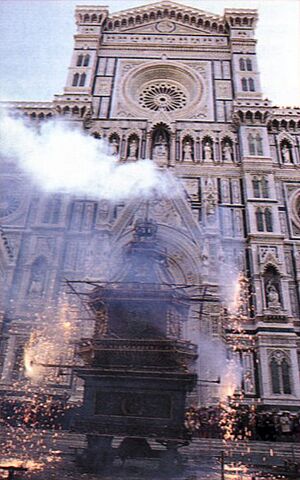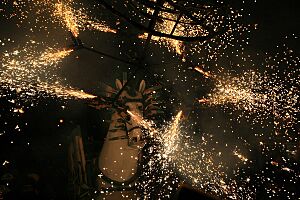Easter in Italy facts for kids
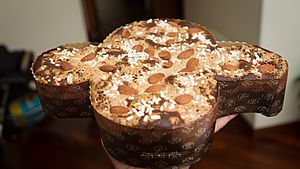
Easter in Italy (Italian: Pasqua) is one of the country's most important holidays. The Easter period starts with Holy Week, which includes Palm Sunday, Maundy Thursday, Good Friday, and Holy Saturday. It ends with Easter Day and Easter Monday. Each of these days has a special meaning.
During Easter, Italians enjoy many traditional dishes. Some popular ones are abbacchio (lamb), Colomba di Pasqua (a dove-shaped cake), and pastiera (a sweet tart). Eating lamb at Easter is a religious tradition. It reminds people of the Death and Resurrection of Jesus. The Colomba di Pasqua is a special Easter bread that looks like a dove. It's similar to the Christmas cakes, panettone and pandoro.
In Florence, there's a unique tradition called the Scoppio del carro (Explosion of the Cart). A special fire, lit from stones from the Holy Sepulchre in Jerusalem, is used to light a rocket shaped like a dove. This dove then flies along a wire to a cart filled with pyrotechnics (fireworks) and sets them off! It's a big, exciting show. Another fireworks display, called the Cavallo di fuoco (Horse of Fire), happens in Ripatransone eight days after Easter.
Contents
Holy Week

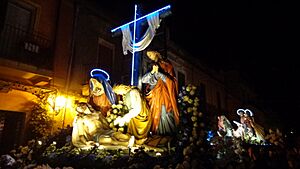
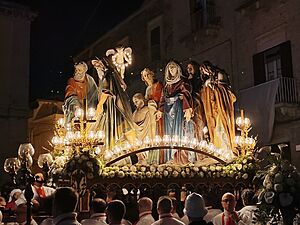
Holy Week is celebrated in many parts of Southern Italy, especially in Sicily. The most famous celebration is in Trapani. It's called the Processione dei Misteri di Trapani (Procession of the Mysteries of Trapani). This event lasts for a whole day! People carry 20 large floats with lifelike sculptures. These sculptures show different scenes from the story of Jesus's suffering and death.
The Misteri procession is one of the oldest religious events in Europe that has happened every year without stopping. It has taken place every Good Friday since before 1612. It lasts for at least 16 hours, and sometimes even more than 24 hours! This makes it the longest religious festival in Sicily and all of Italy.
Other important Holy Week celebrations in Italy include the Holy Week in Barcellona Pozzo di Gotto and the Holy Week in Ruvo di Puglia. The traditions in Barcellona Pozzo di Gotto started a long time ago when Sicily was under Spanish rule. The first procession there happened in 1621.
The Holy Week traditions in Ruvo di Puglia are a big event for the town. They mix old customs with religious practices. Many tourists come from nearby cities and even other countries to see them. These traditions are so special that they are recognized as part of Italy's important cultural heritage.
Popular traditions
Italy has many interesting traditions for Easter (Italian: Pasqua). In a region called Versilia, women who are wives of sailors kiss the ground. They say a special prayer asking for forgiveness from Jesus. In Abruzzo, farmers often add holy water to their food during Easter. People in Julian March also drink holy water on an empty stomach before eating hard-boiled eggs and a type of bread called focaccia.
Fire is another important symbol during Easter. In Coriano, people light big bonfires on Easter Eve. In the province of Bolzano, blessed fire is brought into the countryside. Bonfires are also lit in San Marco in Lamis, sometimes on a cart with wheels.
The use of sacred fire in Florence has changed over time. Long ago, people would light candles in their homes using a special candle that was lit by a lens or flint. Later, three pieces of flint, believed to be from the Holy Sepulcher in Jerusalem, were used. These flints were given to a powerful family called the Pazzi. Eventually, this tradition grew into the exciting Scoppio del carro (Explosion of the Cart), which is a cart full of fireworks.
The Cavallo di fuoco (Horse of Fire) is a historical show in Ripatransone. It's a fireworks display that happens eight days after Easter. This tradition started in 1682. Back then, a fireworks expert finished his show and, for fun, shot off his remaining fireworks while riding his horse. The people loved it so much that they decided to do it every year! In the 1700s, a fake horse replaced the real one, and the fireworks were put on it. At first, the wooden horse was carried by strong people. Later, wheels were added to make it easier to move. In 1994, a new horse made of sheet metal was built, looking just like the old wooden one.
Gastronomy
Italians love to celebrate Easter with delicious food! Here are some of the special dishes you might find.
Abbacchio
Abbacchio is a traditional Italian lamb dish, very popular in Rome. It's a special product that the European Union protects with a special mark, meaning it's from a specific area and made in a traditional way. In the local dialect of Rome, abbacchio means a young lamb that is still drinking milk or has just stopped. A slightly older lamb is called agnello.
In Italy, abbacchio is cooked in many different ways for Easter. In Rome, it's often roasted. In Apulia, it's baked in the oven. In Naples, it's cooked with peas and eggs. In Sardinia, it's baked with potatoes, artichokes, and a plant called myrtle. In Tuscany, it's cooked in a style called cacciatore.
Eating lamb at Easter has a special meaning. For Christians, the "Paschal Lamb" represents Jesus Christ. It reminds them of Jesus's sacrifice for humanity. So, eating lamb at Easter celebrates the Death and Resurrection of Jesus.
Cappello del prete
Cappello del prete (sometimes called tricorno) is a type of Italian cured meat, similar to a large sausage. It's popular in Parma and Piacenza. This food has been around for a long time, since the 1500s. It was often eaten during Easter or Carnival holidays. The name cappello del prete means "priest's hat." This is because the cut of meat used for it, and its special triangular shape, look a bit like the three-pointed hats priests used to wear.
Casatiello

Casatiello is a savory (not sweet) bread that comes from Naples. People usually make it during the Easter season. Its main ingredients are flour, lard (a type of fat), cheese, salami, cracklings (crispy bits of pork), eggs, and black pepper. The name casatiello probably comes from the Neapolitan word caso, which means "cheese," because cheese is a key ingredient in the dough.
Colomba di Pasqua
Colomba di Pasqua (which means "Easter Dove" in English) is a traditional Italian Easter bread. It's like the Easter version of the famous Italian Christmas desserts, panettone and pandoro. The dough for colomba is made with flour, eggs, sugar, natural yeast, and butter, similar to panettone. However, colomba usually has candied orange peel but no raisins. The dough is then shaped like a dove and topped with pearl sugar and almonds before being baked. Some companies also make chocolate versions. This cake became popular for Easter thanks to a baker named Angelo Motta from Milan.
Pastiera

Pastiera is a type of Neapolitan tart (a sweet pie). It's made with cooked wheat, eggs, a soft cheese called ricotta, and flavored with orange flower water. People usually eat it at Easter. There are old stories about how pastiera came to be. One legend says it's connected to a siren (a mythical sea creature) named Parthenope. The people of Naples thanked her for her beautiful singing by giving her ingredients like ricotta, flour, eggs, milk, spices, and sugar. Parthenope then gave these to the gods, who supposedly made pastiera from them!
Penia
Penia is a sweet bread that comes from the countryside in Italy. It's made during the Easter holiday. The ingredients include sugar, butter, eggs, anise seeds, and lemons.
Pizza di Pasqua
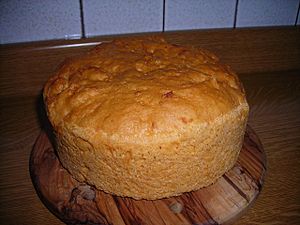
The pizza di Pasqua ("Easter pizza" in English) is a savory (not sweet) cake. It's also called crescia di Pasqua or torta al formaggio in some areas. It's a traditional food in many parts of central Italy. It's made with wheat flour, eggs, pecorino cheese, and parmesan cheese. Traditionally, people eat it for breakfast on Easter morning or as a starter for Easter lunch. It's often served with blessed boiled eggs, a type of sausage called ciauscolo, and red wine. It's also popular for picnics on Easter Monday.
This Easter pizza looks like a panettone (a tall, round cake). It's a typical food from the Marche and Umbria regions. There's also a sweet version. The special shape of this cake comes from the unique mold it's baked in. Originally, these molds were made of clay, but today they are often aluminum. The word pizza here doesn't mean the flat, round pizza we know today. It comes from an old Latin word that meant "focaccia" or "flatbread," suggesting this dish is very old.
Pizzelle
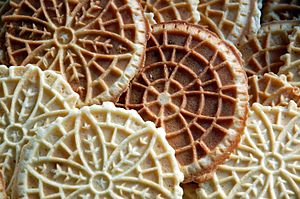
Pizzelle (one is called a pizzella) are traditional Italian waffle cookies. They are made from flour, eggs, sugar, butter or vegetable oil, and flavorings like anise or lemon zest. Pizzelle can be hard and crispy or soft and chewy, depending on how they are made. They can also be shaped into different forms, like the tube shape used for cannoli.
Pizzelle were first made in Ortona, in the Abruzzo region of Southern Italy. Many other cultures have similar cookies. Pizzelle are thought to be one of the oldest cookies, possibly coming from an ancient Roman cookie called crustulum.
Pizzelle are also known by other names like ferratelle or nevole in some parts of Abruzzo and Lazio. In Molise, they might be called ferratelle, cancelle, or pizzelle. These cookies are very popular during Christmas and Easter. You often see them at Italian weddings, along with other traditional sweets. Sometimes, two pizzelle are sandwiched together with cream cheese filling (ricotta mixed with sugar) or hazelnut spread. While still warm, pizzelle can be rolled around a wooden stick to make "cannoli" shells.
See also
- Holy Week in Barcellona Pozzo di Gotto
- Holy Week in Ruvo di Puglia
- Scoppio del carro
- Cavallo di fuoco
- Public holidays in Italy
- Christmas in Italy


